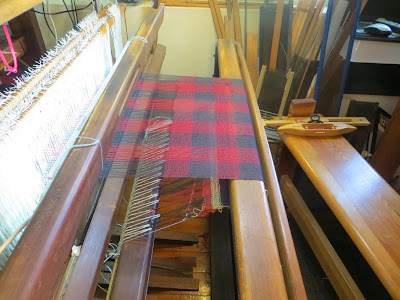We are having a very nice summer and what with camping, gardening and messing about in boats I have spent a lot of time
Not Weaving. Momentum has picked up now, mainly because the scarf is intended as a Christmas present.
 |
| Sleying the reed |
In a my last post I wrote about how I cleaned the reed. It ended up a nice dark grey colour which unfortunately was an almost exact match with the dark grey of one of my weft yarns. Needless to say I had a couple of sleying errors
and they were close to the centre of the reed.
In the past I have balanced the reed on boxes when sleying; silly, it is much easier to hang it from the superstructure.
 |
| Open sett means see through cloth |
When I started the weaving I had a problem because I found it difficult to see the fell clearly and judge my beat. The set is very open (12 ppi for the Mora and 16 ppi for the Merino) so the cloth is see through with lots of visual distraction coming through from below.
 |
| Three lights at the front of the loom |
I put extra lighting onto the loom. The little clip on lights that I have put onto the beater uprights are invaluable - I use them all the time and move them around as needed
 |
| Light behind the beater |
 |
| The sample |
In addition to the three lights shown above there is a neon light (turned off in the photo) attached to the back of the top beater bar. This shines down and through the red giving a good view of the fell.
This is the sample. I have made it larger than I normally do because it will be needed for determining the amount of finishing that I will need to do to get the right degree of shrinkage and pucker.
 |
| Measuring 14 ppi |
In theory I should be beating the red Mora wool to 12 ppi and the grey Merino to 16 ppi. Swapping every 2"proved too much for me so I have settled for 14 ppi throughout. I could probably have set the whole warp at 14 ppi.
 |
| Washers (nuts) in the boat shuttle |
I normally use end feed shuttles but because this CB loom beater does not have a shuttle race on the bottom batten I decided to use lighter boat shuttles. I had a problem with the spools catching and snagging but a couple of nuts serving as washers has fixed the problem.
I am now well into the actual scarf having woven about 2' today in a couple of gentle sessions. I should make it for Christmas!































